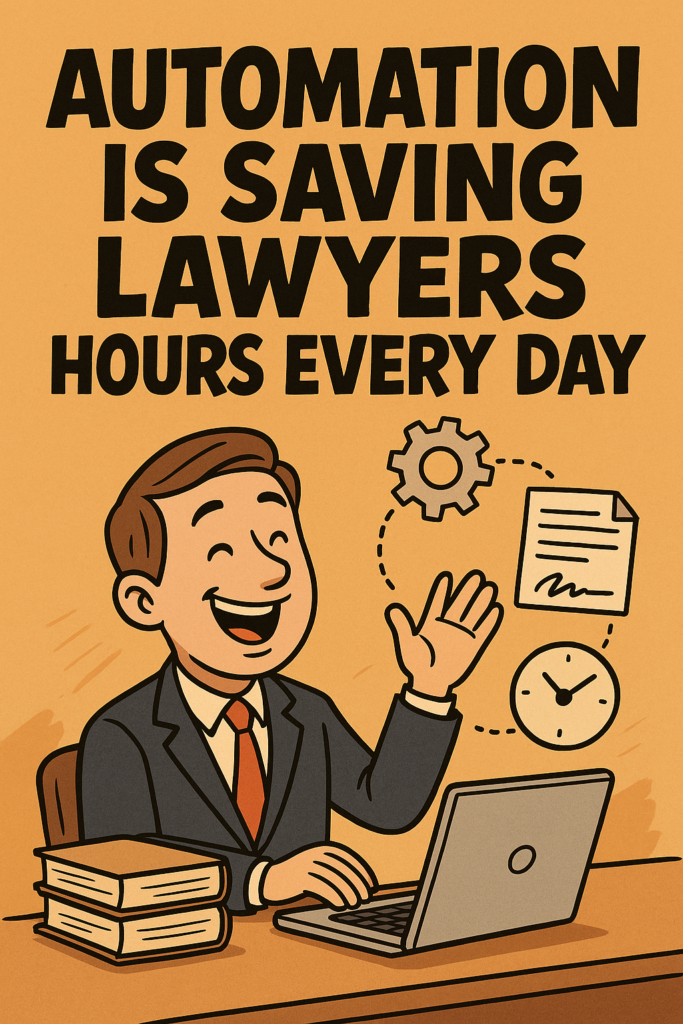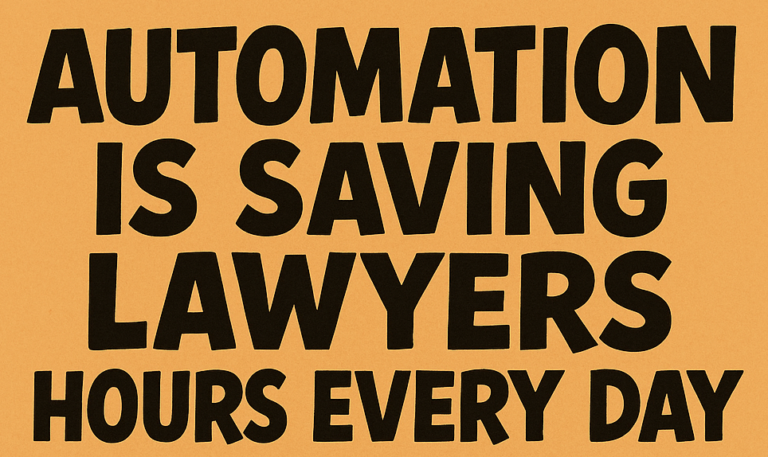There are many different ways to save lawyers hours of wasted time. I’ve lived this and I have sold software to law firms. For years I also ran a law firm (that did divorce law) and saw overcaffeinated associates burn out on mind-numbing intake tasks and watched law firms hemorrhage money chasing “improvement” with software they that they didn’t need. Based on my experience, this is what works, what fails, and what’s actually making money for firms using automation in 2025.
Client intake, document generation, and legal research are the three-headed beast of inefficiency in small to mid-sized law firms. You want to talk about saving lawyers hours, then let’s start where time gets torched.
Intake first
A law firm I worked with in downtown Vancouver on Dunsmuir used to have two full-time admins just to book consults, collect client info, and chase down missing documents. Average time per intake was 63 minutes. Multiply that by 10 new inquiries per week and you’ve lost 10.5 hours before the lawyers even touch the file. Now, I convinced them to switch to Lawmatics. The setup took a week. They cut intake time to nine minutes per client. That’s a 600% time savings. You could literally nap through your lunch break and still have hours left over.
The law firms conversion rate jumped from 42% to 68% because people hate friction. If they can sign retainer agreements on their phone and book appointments without a call, they do. And they don’t ghost the law firm.
The law firm firm was billing $6,000 per client on average. At ten consults per week, the old system brought in four clients = $24K weekly. With automation, 6.8 clients = $40.8K. An extra $16.8K/week from fixing a broken intake flow. That’s almost $875K/year. You could buy two Teslas and a new receptionist and still come out ahead.
Saving lawyers hours with AI legal research
Traditional legal research is soul-draining. I once watched a junior associate spend 3.5 hours pulling comparative decisions for a landlord-tenant case. This was done only to miss the most recent ruling that reversed the trend. The problem wasn’t their effort, it was that they were doing things manually.
Here’s where Caseway comes in. It’s not sexy, but it works. The machine chews through over 100 million rulings. I’ve tested it side-by-side with Westlaw and CanLII. Caseway surfaced relevant, recent precedent in under 90 seconds. Westlaw buried it on page 5. CanLII was hard to search.
And here’s what I love: it is trained to not hallucinate. It doesn’t quote blogs from unknown authors. No summaries written by interns, it only quotes court decisions. You ask, it answers. One Vancouver law firm told me they slashed memo prep time from five hours to 45 minutes. When you bill at $350/hour, that’s $1,575 saved per memo. Multiply that by 3 memos a week per associate over a year, then you just saved $245K per associate.
I’m not just throwing numbers at you. I’ve used this technology myself. My own former law firm moved from a traditional model to mostly flat fees using Caseway and automated templates. We weren’t losing money. We were making more. This was because when your staff isn’t wasting time doing work a machine can do in seconds, they’re either billing or building the law firm.

Let’s get into document automation
PracticePanther, Rally, Lawcadia all do roughly the same thing. They pull in client data and auto-populate retainer agreements, NDAs, affidavits, whatever. I once helped a sole practitioner in Richmond BC who was drowning in landlord disputes. Every demand letter started the same. He spent an hour writing each one. I built him a workflow with Rally. Now it takes six minutes. He literally creates letters on his phone while watching hockey. You think he’s going back to Word templates and Ctrl+F? Not a chance.
Look, I’ve seen the objections.
“Automation takes the human touch out of law.”
The human touch isn’t in chasing signatures or emailing intake forms. It’s in strategy. In negotiation. In trial. Automation just gets you to those high-value moments faster. If anything, it gives you more time to be human.
Our Law Firm Is Too Small
Or my personal favorite: “Our law firm is too small to use automation.”
That’s like saying you’re too broke to buy groceries, so you eat out every night. If your firm has under ten people, automation isn’t optional. You either spend money fixing the leaks or watch your time and energy spiral down the drain.
Let’s do another example.
A two-person firm in Kelowna handling ICBC claims was hitting a wall. Intake was slow. Clients ghosted. Docs were disorganized. I introduced Lawcadia. They got e-sign, document workflows, reporting dashboards. All of this was done in one place. Their turnaround time on client onboarding dropped from 6 days to 36 hours. They stopped losing files. Their positive reviews shot up on Google. They stopped bleeding referrals. You want to compete with big firms, then look like one.
Even the client experience gets better. People don’t want to print, sign, scan, and email anymore. That’s 2005. That was twenty years ago. Now people want to tap their phone twice and get confirmation. You meet them where they are, or they find someone else who does.
Saving Lawyers Hours And The Cost
These software tools are not free. But they’re not expensive either. Lawmatics starts at $150/month. PracticePanther, a little less. Even Caseway, which handles millions of cases, runs about $49/month per user. If that saves you one hour a week, and it will, you’ve paid for it ten times over.
Here’s the gut check. If you’re billing $300/hour and wasting 10 hours a week on admin tasks, that’s $3,000/week. Over a year, you’re burning $156,000. But a tech stack might cost you $5K/year. That’s a 31x return. Not bad for clicking “Sign up.”
What’s wild is how many firms resist this. They’ll pay $40K for an office renovation but won’t spend $500/month to triple their law firm profitability. You don’t need marble countertops. You need client forms that don’t go missing.
I’ll wrap with this: I’ve worked with over 80 law firms in the past few years. The ones growing aren’t smarter. They’re not even better lawyers. They just stopped doing things the hard way.
Automation is the new standard. You don’t need to be first. But don’t be last.
GI’ve tested all of these tools in the wild. I’ve seen the good, the bad, and the “why does this feature even exist?” Don’t keep telling yourself you’ll automate “next quarter.” That’s lawyer-speak for never.
Does saving lawyers hours at your law firm sound good? Then get on it.
Author: Daniel S. Whitmore, J.D., LLM. Daniel S. Whitmore is a legal technology consultant who specializes in helping law firms optimize efficiency through automation.


